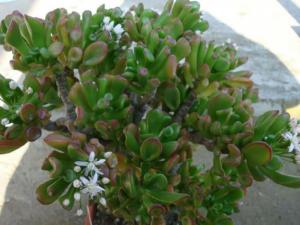Hobbit jade plants do best in well-draining soil
While correcting school papers in the 1930s, the teacher idly scribbled, “In a hole in the ground there lived a hobbit.”
The teacher finished correcting the papers and finished a manuscript based on that opening line. Publisher Stanley Unwin paid a shilling to his 10-year-old son Rayner to give him a book report on the manuscript. Based on this positive review Allen & Unwin published 1,500 copies of Tolkien’s book, “The Hobbit or There and Back Again.” The book has gone on to sell over 100 million copies.
The Hobbit is a favorite of young male readers, perhaps because it avoids any mushy romances. Indeed, there is not a single female character in the book. The only mention of any woman by name is Bilbo’s mother, Belladonna Took.
Hobbits are by nature lovable, nice and quirky. It is that quirkiness perhaps that gives us the hobbit jade plant (Crassula ovata). Unlike the common flat-leafed jade plants, the hobbit jade plant has waxy tubular or pipe-shaped leaves with colorful light red tips. It blooms with tiny, star-like flower masses in umbels.
This slow-growing succulent easily grows to three feet and can spread out four feet if you let it. Like any hobbit, your hobbit jade plant is easy to get along with and trouble free.
Grow your hobbit jade plant where it will get at least four hours of bright sunlight every day. They will survive in indirect light, but for best colors and healthier pants keep them in bright light.
Hobbit jade plants do best in potting soil that drains well. Ideal soil acidity is pH 6.0. Specialty cactus and succulent potting soils are readily available, or you can make your own. To make your own succulent potting soil mix three parts potting soil, two parts sand and one part perlite.Don’t use potting soils that have fertilizer already mixed in. Hobbit jades like quick-draining soil, so avoid potting soil that contains vermiculite or additives to retain water.
Water your plants regularly during spring, summer and fall, but cut back during the winter. Always let the top inch or so of soil dry out between waterings. Unlike many houseplants, the wily hobbit jade doesn’t need a lot of humidity, so always empty any water from the pot’s drainage saucer.
You can fertilize your hobbit jade plant every three to four months while it is actively growing, but hold off feeding during the winter months. Keep your hobbit jade away from drafts.
Hobbit jade plants prefer their roots be slightly crowded, so keep them in tight pots and only repot when absolutely necessary. Because of their top-heavy growth choose wide pots so they don’t tip over.
The durable hobbit jade plant works well for bonsai, and is a favorite beginners’ bonsai.
Anything named hobbit should involve generosity, and the hobbit jade fits right in. It is easy to propagate plants for gifts. Grow new hobbit jade plants with leaf or stem cuttings.
Let the cuttings dry out slightly overnight and callous over before planting. These root easily, and soon you will have hobbit plants to give friends or any passing Bilbo Baggins.





















































